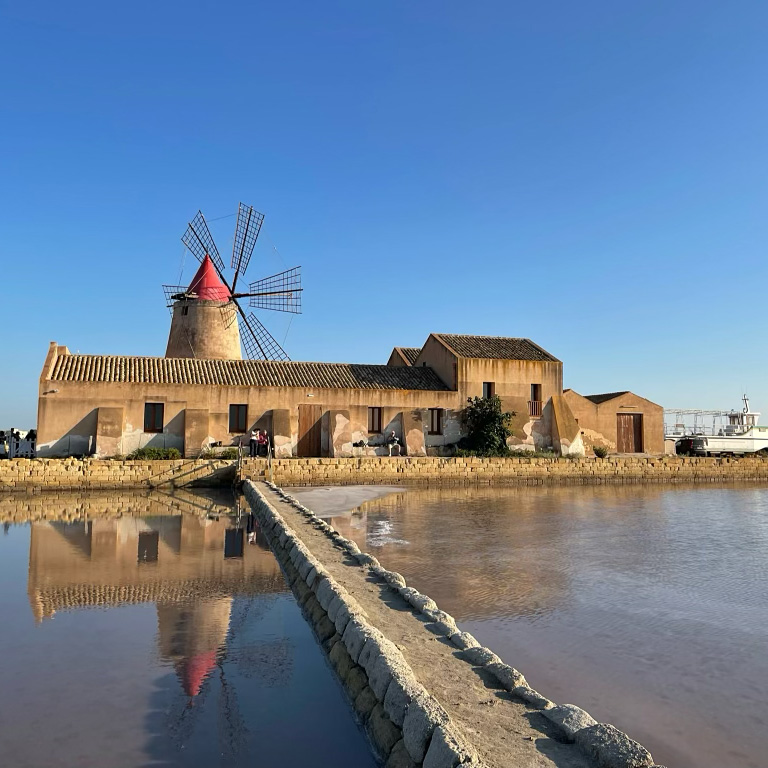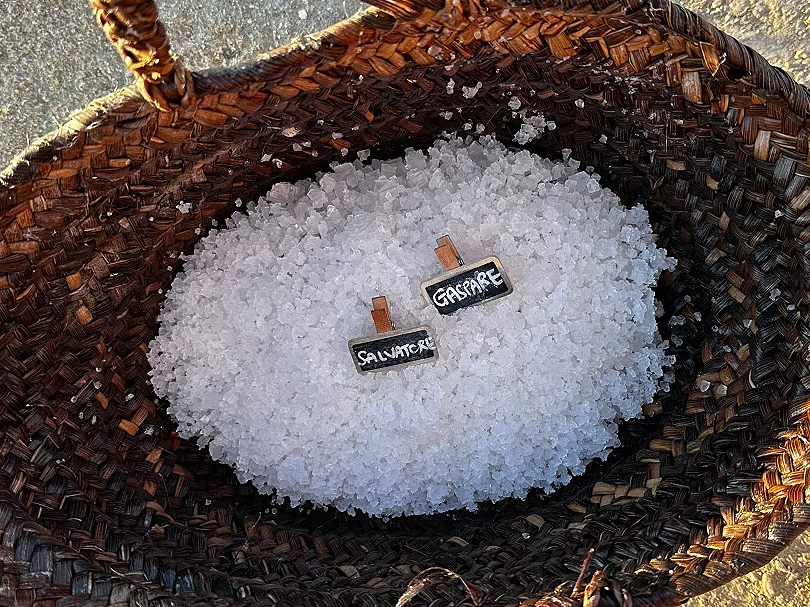SALE (SAH-lay)
Anthony Giglio grew up in a row house on the west side of Jersey City, where his maternal grandmother immersed him in a tapestry of Italian culinary traditions and heartfelt rituals. These early lessons in life shaped his culinary journey as a sommelier and writer and instilled in him a profound appreciation for the art of seasoning and the slow, deliberate process of preparing and enjoying food. In this article, Giglio takes us to his childhood and as far back as the 7th century BC and the Roman Salt Road. Enjoy the journey.
Salt carefully, yet powerfully
“Who’s ready for a bath,” my maternal grandmother, Rose — aka Nanna — asked in her sing-song voice to the only person in her kitchen as I raised both arms for her to pull my t-shirt up and over my head. I loved taking bubble baths in her mid-century espresso-brown kitchen sink. Nanna lived with my grandfather, Jim, in the apartment above ours, on the second floor of a clapboard rowhouse on the West Side of Jersey City, where we moved in 1969. In the front garden stood a statue of the ‘Sacred Heart of Jesus’ in a five-foot-high clamshell, his arms outstretched to bless all who passed by. Strangers thought our house was a rectory. From one of her kitchen windows, the one to the right of the radiator — atop which she was fermenting pizza dough in a huge ceramic bowl wrapped in a blanket — I could see the Twin Towers rising across the Hudson River. Before she could plop me into the sink, she had first to lift the heavy bowl of salt cod out, which she had been soaking under a slow but steady stream of cold water for hours. “One fish out,” she said, exaggerating the heavy lift, placing the bowl on the counter, “and another one in,” she continued, hoisting me into the sink. As the water and bubbles rose around my lap, she’d hum-sing Neapolitan hymns while baptizing me with water she poured over my head from a clear plastic Tupperware measuring cup. “La vit è bell’” she’d sing in her clipped Napolitano dialect, “life is beautiful.”
Salt cod — baccalà — is the fish of my childhood, especially during the meals shared in Nanna’s apartment on Fridays and Sundays. Salted cod was a traditional dish of Italy’s cucina povera; it was the original Slow Food because it took days of soaking to reconstitute and desalinate it. For working-class families like ours, my grandmother could leave her prepared, salted cod submerged in water in her deep sink all day while she was sewing zippers into pants at a factory nearby, then return home in the evening, drain the sink, rinse the fish, and repeat overnight. There was a longstanding tradition in our family to choose fish over meat for certain meals, a tradition deeply rooted in a promise my Nanna made during a challenging time in history: If her brothers returned safely from the Second World War, she would continue this practice every Friday as a lifelong commitment. Her brothers came home, and for the rest of her Fridays on this earth, we hit the baccalà lottery, lightly floured and browned in olive oil, then simmered with homemade tomato passata, potatoes, black olives, and oregano. The rich blend of sweet, savory, and briny aromas from this dish is something I can recall vividly, a cherished memory that feels as close as the kitchen of my childhood.
Once I was old enough to be trusted holding sharp utensils and cooking on the stove, Nanna taught me how to make doughs for pizza, batters for cakes, all sorts of pasta, sauces for pasta, gravy for meats, and dressings for salads. From her, I not only learned how to remove the salt from her beloved salt cod but also how to add salt to recipes by way of savory staples in the Italian Pantry: Parmigiano-Reggiano, Locatelli Romano, provolone, prosciutto di Parma, soppressata, capers, and, of course, anchovies and sardines. The tragic irony of all of this is that amid all these lessons (well into my teens), Nanna was diagnosed with hypertension and forced to limit her salt intake severely. Regardless, my palate was well attuned to seasoning by then, so I took over salting on her behalf.
Italians didn’t invent salt, but their cities were founded according to their proximity to saltworks, as their Etruscan and Roman forbears certainly knew a great commodity when they tasted it. As far back as the 7th Century BC, Rome started building its saltworks to break its dependence on Etruscan salt, founding the Via Salaria — the Salt Road — to distribute it to the burgeoning empire along the Italian peninsula. Then, in the 4th Century BC, Rome was sacked by the Celts and brought with them their savvy for widespread salt trading. It’s worth pointing out that the Celts of Northern Europe were called the Galli, or Gauls, by the Romans, a word derived from hal, the Greek word for salt, referring to the Celts/Gauls as the salt people.
A few centuries later, in 51 BC, Julius Caesar conquered Celtic Gaul. The Roman victory was total. As Mark Kurlansky writes in his epic paean, “Salt: A World History” (Penguin, 2003), “Celtic inventions — in salt mining, iron, agriculture, trade, horsemanship — enriched the Roman Empire. Celtic salt mines became part of Roman wealth, and Celtic hams became part of the Roman diet, with few ever remembering that such things were once Celtic. The Celts were innovators. The Romans were nation builders.” That’s right; the pig-loving Celts are credited with salting the legs of wild boars, giving Western culture the first salt-cured hams.
Kurlansky said that salt was a necessary part of empire building for the Romans; they developed saltworks throughout their expanded world, establishing them on seashores, marshes, and brine springs throughout the Italian peninsula. By conquest, they took over not only Hallstatt, Hallein, and the many Celtic works of Gaul and Britain but also the saltworks of the Phoenicians and Carthaginians in North Africa, Sicily, Spain, and Portugal. If that weren’t enough, they acquired Greek, Black Sea, and ancient Middle Eastern works, including the saltworks of Mount Sodom by the Dead Sea. More than 60 saltworks from the Roman Empire have been identified. At times, they even paid their soldiers in salt, which is where the word salary comes from, as well as the phrases “worth his salt” or “earned his salt.”

In the 3rd Century BC, between the bookends of the Celts sacking Rome and Rome subsuming the Celts, Sicily made salt in the marshlands around Trapani on the island’s west coast. That tradition still lives on today. I’ve traveled and curated wine, food, and history tours of Sicily since 2006. This is how I have found myself several times up to my knees in gloriously pastel-colored salt marshes in the shadow of a 16th-century windmill that is still grinding salt today. I fell in love with this salt and with this place. For many years, I brought home bags of still-damp sale marino (sea salt), nearly opaque or gray (sel gris, as the French say), because it was impossible to find here until recently.
Eventually, I started tinkering with salt blends, mounting kosher and sea salt with fresh garlic and herbs, mashed into a paste, and then mixed into the salt. I’d often make a quick batch of this as a gift for friends when they invited me for dinner. Over the years, so many people asked me to make more of it to share that I eventually scaled it up to massive amounts, drying it for days in dozens of sheet pans on my dining room table. In our apartment building here in the Heights neighborhood of Jersey City (yes, I still live here!), neighbors on the fifth floor would text me on the first floor to ask if I was drying salt — they could smell it up there! I likened my “super salt” to a powerful flavor vehicle, insisting that it could save home cooks a lot of time by using it instead of lackluster dry herbs or having to chop everything fresh.
I’d like to think that Nanna — who I was fortunate to have in my life well into my 40s (she passed away in 2009) — would be proud of this latest chapter in my culinary evolution. My only hope (and fear) is that I don’t inherit her hypertension. Thus, I salt carefully — yet powerfully.

Anthony Giglio is a journalist, sommelier, and storyteller. He is the Wine Director for the American Express Centurion Global Lounge Collection and a longtime contributing editor to FOOD & WINE magazine.
In 2019, Giglio, finally took the plunge and SUPERSALT was born. Made of Sicilian sale marino, as a tribute to his wife, Antonia, whose family emigrated from Sicily in the 1960s, and his love of the salt from Trapani. The salt is harvested, then packed in Bologna with fresh herbs and garlic, and imported to the United States. You can find SUPERSALT online here.
All photos courtesy of the author.
SUPERSALT is a registered trademark and property of Side Gig, LLC, and is not affiliated with Massican.
